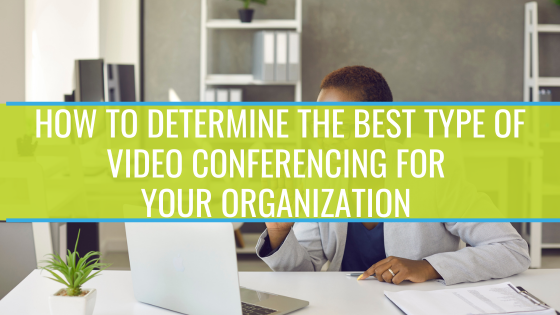
How to Determine the Best Type of Video Conferencing for Your Organization
What Types of Video Conferencing Solutions are Available for Businesses?
Video conferencing systems can be categorized into a few groups, including:- Video conferencing software - Video conferencing software is typically run from a desktop, laptop, or mobile device. Other than that, there are no hardware requirements, so users can easily conference from their workstations. Popular software solutions include Zoom, Microsoft Teams, Cisco Webex, and others. These solutions are also supported by various hardware solution providers, including Poly and Crestron - so you can run a well-featured Zoom or Teams meeting from your hardware, as well.
- Room conferencing systems - Room conferencing solutions are built on hardware, and such a solution combines the conferencing codec itself, along with cameras, displays, microphones, speakers, processors, and other components. Hardware solutions are prized for their reliability and excellent call quality. Room conferencing solutions are built for a range of room sizes, including all-in-one hardware solutions that are perfect for small team meetings.
- Immersive telepresence solutions - Immersive telepresence solutions are the most sophisticated and fully featured room solutions available. Immersive telepresence combines top-flight hardware with streamlined controls for an unmatched conferencing experience. Built for enterprise organizations, immersive telepresence provides numerous benefits to a business’s conferencing approach - including excellent reliability, large team meeting capabilities, and extensive content sharing features.
Opting for a Room System? Here's What to Consider
Many organizations dedicate a room for their video conferences, for a few reasons. With dedicated conferencing rooms, it's easier for organizations to organize their space resources, encourage better collaboration, and support a professional environment. If this is the direction your organization prefers, here are some things to consider for your room conferencing system:- The room's size and layout - The biggest factor is the size and orientation of your meeting room. All-in-one hardware systems like the Studio are available in several models, each designed for a certain size of room. For huddle rooms, where only a few people fit, the Studio X30 is optimally sized. For large conference spaces, the Studio X70 offers more robust audio hardware and a pair of 4K lenses. And for expansive boardrooms, Poly has a large room kit that includes additional hardware options.
- The room's acoustics - The room's shape and composition will influence audio quality. AV integrators are equipped with baffles, sound-dampening materials, and other audio-enhancing tools to minimize echo.
- The room's other technologies - Many meeting rooms are also equipped with other technologies - interactive displays and presentation systems foremost among them. Video conferencing solutions can connect to some of these extra technologies and incorporate them into the call. For instance, interactive displays like the Clevertouch or Samsung Flip can be linked into a call, so remote participants can see and even interact with it.
An AV integrator can point out which video conferencing solutions are compatible with your other conference room technologies. That way, there's no frustrating surprises when testing out your new equipment.
- The system's ease of use - When it comes to video meetings, easier is better. That's why usability should be a major focus, especially if there isn't an AV or conferencing tech specialist on staff. Fortunately, top conferencing system manufacturers have also made usability a focus. All-in-one hardware solutions are the pinnacle of this approach, but most top end solutions can be simply operated from a touchscreen. Incorporating such a touchscreen into your system can resolve most frustrations before they start.
Sticking With a Software Solution Only? Here's What to Look For
Smaller companies generally have smaller conferencing needs, and there are smaller solutions for those smaller scale needs. While SMBs can still benefit from a full-featured conferencing room, with better communication being an advantage, many prefer software-only solutions until they scale up to a hardware-based system. If your organization is interested in software solutions only, here's what to target:- Support for enough participants - Software solutions are limited by the number of simultaneous participants or calls. If your organization makes a lot of video calls, or plans to, make sure there's enough room in your plan for everyone. In general, the more people using the platform, the more licenses you'll need.
- A simple user interface - Usability is a major selling point for software solutions - in fact, better usability was Zoom's initial pitch to users. There are numerous software offerings out there, many with free trials or plan options. Experiment with a few and see which one best fits your team.
- Content and screen sharing features - Some organizations only use their video conferencing system for face-to-face conversation. Other organizations use the technology as a content sharing medium. Images, videos, documents, spreadsheets, concept drawings - all can be shared through leading conferencing solutions.
Zoom, Teams and some others also come with screen sharing features, which is perfect for webinars, training, and instructor-led meetings. It’s important to note that screen sharing is a premium feature for most video conferencing services, so it will need to be priced in.
Another content-related feature worth having is conference recording. Conference recording can be toggled as an automatic feature and provides a downloadable file as soon as the call is over. It's a handy reference for participants to have while working on long-term projects.
- Integration with third party applications - Well-supported software solutions can typically be used with a variety of third-party applications for additional functionality. Slide presentation apps (like PowerPoint), meeting scheduling and calendar apps, e-mail and transcription apps - your team may already be using some of these. With the right conferencing solution in place, they can play a role in your video calls, too.


